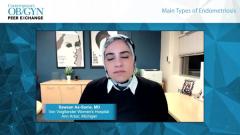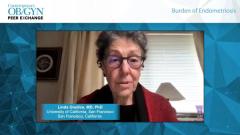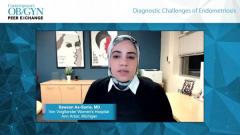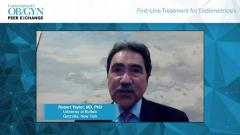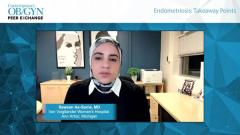
Endometriosis: Surgery and GnRh Agonists
Sawsan As-Sanie, MD, Jessica Shim, MD, Robert Taylor, MD, PhD, and Linda Giudice, MD, PhD, discuss the role of surgery and GnRh agonists for the treatment of endometriosis.
Episodes in this series

Hugh Taylor, MD: Is there any indication to still use a GNRH agonist?
Sawsan As-Sanie, MD: It probably goes back to patient preference. The advantage of having an oral medication, which you can start and stop quickly, is definitely an advantage for some patients. But for some patients who prefer to take an injection and forget about it for a couple of months, there still might be a role. I have some patients on the depot version of a GNRH agonist, and I’ve used it off-label for quite some time for patients for long durations. But after 6 months of use, we’ll make sure that I’m giving them some type of add-back therapy for bone-mineral-density protection. It varies from patient to patient based on their preferences, in terms of how they take their medication and what they’re used to. For patients who’ve used it for many years, I tend to not rock the boat. If it’s been working, we’re going to stick with it and not necessarily change because we’re not looking to exacerbate or withdraw patients from their success.
Hugh Taylor, MD: I have a few of those who don’t want to change. I start an add-back therapy immediately when I start a GNRH antagonist. If I’m going to keep them on for a prolonged period of time, then I also check out a bone-density scan. But I’ve got a few patients who don’t seem to respond to the partial suppression with the antagonist. You get that more profound full suppression with an agonist, and then you can customize your add-back. In those rare patients who really need that, I’m still using a GNRH agonist, but rarely.
Linda Giudice, MD, PhD: There are 2 other areas where a GNRH antagonist is preferable. One is for patients who have extra pelvic endometriosis. Right now, we have almost no information about how the antagonists work. We have more data, even though the patient populations are not very big with, say, catamenial pneumothorax with regard to either a progestin or a GNRH agonist. The other group is [patients with infertility]. We’ll be seeing data in the [coming] months and years with regard to suppression for patients with infertility who have suspected endometriosis or some indication by tests, [which will help] improve implantation rates. Norethisterone acetate as a progestin is 1 thing that’s been shown to improve implantation rates along with GNRH agonists, but I haven’t seen any data with regard to GNRH antagonists.
Hugh Taylor, MD: We’re doing that trial right now. It’s a large NIH [National Institutes of Health]–sponsored multicenter trial. Give us a couple of years, and we’ll have some data for you.
Linda Giudice, MD, PhD: Fantastic. Good.
Robert Taylor, MD, PhD: Hugh, precocious puberty might be a situation where the GNRH superagonists will still play a role. Jess might be able to address this better than I can, but kids who aren’t going to be compliant very much with oral medication and the depot injection might suppress them more reliably.
Jessica Shim, MD: Definitely. We use a lot of GNRH agonists for precocious puberty, although the length of duration of those therapies aren’t as long, so I’m not sure if it can necessarily be extrapolated for adolescents with endometriosis. We have some data using GNRH agonists and adolescents. We had a randomized control trial from 1 of my colleagues that looked at using add-back therapy and what is a good add-back therapy in adolescents who are on GNRH agonists. I haven’t seen as much data on GNRH antagonists in adolescents with endometriosis, though. I’m curious if you guys know much of that data. It’s a relatively newer drug, so I’m curious and interested in seeing more of those data come out for the younger population.
Hugh Taylor, MD: Obviously, they didn’t include adolescents in the phase 3 trials that led to approval. They’re all over 18. But anecdotally, I’m hearing about a lot of people using them, and I think we’ll see some data forthcoming. It seems to be very effective there as well.
Rob, is there any reason to use an aromatase inhibitor? We talked about that in the past. It’s in combination with something else, and it’s never a first-line therapy. But do you ever use aromatase inhibitors in your practice?
Robert Taylor, MD, PhD: Yeah. I haven’t had the occasion much. Serdar Bulun published some of the first clinical reports of using aromatase inhibitors in that setting. Those were in postmenopausal women. He demonstrated that they had the ability, that the lesions themselves had the capacity, to aromatize adrenal androgens and stimulate the endometriosis to grow. It made a lot of sense in that setting, and he saw some anecdotal good clinical responses in that. As you pointed out, in a cycling woman, aromatase inhibitors can increase pituitary hormone production, and that could potentially exacerbate the situation. I don’t know if there are many settings in which that’s likely. Maybe in combination that might be useful. I haven’t had a lot of cases other than the postmenopausal subjects.
Hugh Taylor, MD: I have occasionally as an adjuvant [therapy]. You always want to suppress the hypothalamic-pituitary axis before giving an aromatase inhibitor with a progestin or a GNRH agonist or antagonist. Occasionally, I’ve found some added value, but not overall, so I tend to use that infrequently.
Robert Taylor, MD, PhD: You’ve done a couple of cases with the bazedoxifene combination. Tell us a little about that.
Hugh Taylor, MD: I was going to save that for the new and upcoming future directions and unmet needs, but I might as well jump in here. We’ve seen that SERMs [selective estrogen receptor modulators] have antiestrogenic properties in the uterus and were designed to replace progestins in hormone replacement therapy—just for that purpose, to not stimulate endometrium. Similarly, it blocks estrogen action and endometriosis. We’ve seen some nice effects in animal models and in some human trials using the bazedoxifene-conjugated estrogen formulation, but that’s temporarily unavailable in the United States, so I’m not using it. We have had some success with that alone, and I love the idea of using it as an add-back therapy as well, often with a GNRH agonist or antagonist because of that bazedoxifene effect, especially for somebody who’s sensitive to progestin-related adverse effects. That’s another option.
Linda Giudice, MD, PhD: I’ve used it in exactly those indications with pretty good results: bazedoxifene and usually a progestin as well.
Hugh Taylor, MD: [I’ve used it] as an adjuvant or progestin or as my add-back therapy for a GNRH agonist or antagonist.
TRANSCRIPT EDITED FOR CLARITY
Newsletter
Get the latest clinical updates, case studies, and expert commentary in obstetric and gynecologic care. Sign up now to stay informed.

